In this paper, we investigate the process of generating modern multimedia-based learning material. The current status of the computer equipment utilised by the students was analysed and multimedia material suitable for the students' equipment was produced. The material is built on a CBE (Computer Based Education) concept that was developed in an earlier pilot project. The produced material covers the main areas of the course "Signals and Systems", taught in the Department of Electrical and Communications Engineering at the Helsinki University of Technology (HUT). The effort needed for constructing such material was analysed. The quality of the material was evaluated by distributing the implemented software to the students and assessing the benefits of using the material.
KEYWORDS: MULTIMEDIA TEACHING, CBE, CD-ROM
From the beginning of the history of the computer, there have been various attempts to use computer and software programs for teaching purposes. The potential benefits that Computer Based Education (CBE) offers are considered tempting and promising among teaching material producers. In many areas, there is a need for more efficient teaching methods and also a lack of teaching recourses due to increasing student volumes. Production of CBE material has, however, faced difficulties, since the production process has been very demanding and expensive. This has changed dramatically during the last five years; the development tools for multimedia authoring, graphics production and voice production have experienced a rapid development. The production of high-quality multimedia material is now easier and faster than ever before. In addition, the latest versions of the multimedia authoring tools usually support network-based distribution by utilising efficient compression on streaming technologies, bringing new possibilities to the distribution of the study material. On the hardware side, the equipment that can execute rich multimedia presentations has been expensive and thus has not been affordable by students in general. The rapid evolution of the PC-computer has made it powerful enough to execute processing-intensive multimedia presentations. At the same time, the cost of the PC-computer has gone down resulting in an increased penetration of computers.
The work related to this paper is based on a previously documented pilot project [1], in which the multimedia CBE concept was developed and 30 % of the material of a specific course, "Signals and Systems", was organised into a developed platform. The main objectives of the present project, in addition to the produced material itself, were to follow the evolution of the students' hardware, to analyse the effort needed to produce multimedia material on a larger scale, and to evaluate the quality of the produced material.
The results of this survey of the students' hardware are presented in the second section. In the third section we briefly describe the pedagogical multimedia concept and the platform that was designed during a previous pilot project. The effort needed for producing multimedia material is presented in the fourth section. In the fifth section, we evaluate the quality and the usability of the CBE concept and the learning material. Finally, in the last section we draw the conclusions.
Two different inquiries have been organised to investigate the development trends of the computer hardware utilised by the students. The first survey was conducted in autumn 1997, and the second in spring 1999. The survey was organised in connection with a course that is obligatory for all students studying in the Department of Electrical and Communications Engineering at the Helsinki University of Technology. In the first survey, 237 students attended the course of which 218 took part in the survey, resulting in a turnout of 92%. In spring 1999, correspondingly, 350 students attended the course of which 244 took part in the survey, resulting in a turnout of 73%.
We have collected information on the computer penetration among the students participating in different courses in the Communications laboratory. Based on these inquiries, we estimate that the overall computer penetration among the students in the department is 85 %. The high penetration indicates that students lacking the necessary equipment efficiently utilise the computer hardware in the classrooms provided by the university. Thus, the CBE material is accessible by practically all students.
Fig. 1 summarises the types of computer owned by the students, and illustrates the development trend between the two surveys. The quality of the equipment has been improving rapidly, since within 18 months the number of 486-type processors has dropped considerably and the Pentium-level processors have reached a 94 % share of the total computer population. There are now less severe restrictions on the multimedia material itself, since the minimum hardware requirement can be shifted to a Pentium-level processor. This is an important improvement, since many concepts - like audio decompression - require a Pentium-level processor.
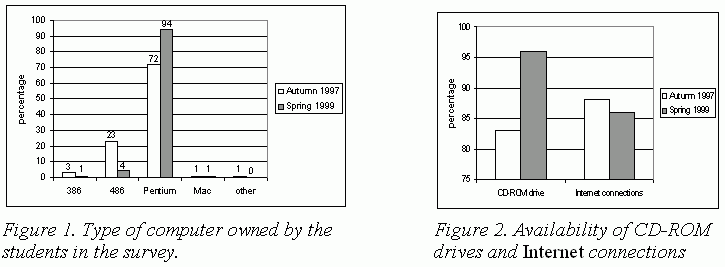
Fig. 2 presents information for selecting a suitable distribution channel where, in practice, the choice is between internet/intranet and CD-ROM. It seems that the students are reached more efficiently through CD-ROM; however, network-based distribution might offer some other benefits. The greatest advantages provided by network-based distribution are more flexible updating and publication of the material and better control over unauthorised usage.
The implemented CBE concept was developed during a previous pilot project and is described here only briefly. A more detailed description can be found in [1]. When designing a modern multimedia application, both pedagogical and technical aspects should be taken into account. On the technical side, one of the most important aspects is the flexibility and easiness of the management of the material. In practice this implies a highly modular system, where the replacement and addition of different software modules is made as easy as possible. When designing the CBE concept, one should also always keep in mind the possible future needs and trends. The distribution channel might be different in the future, there might be a need for other language versions, etc.
On the pedagogical side, modern multimedia methods can offer potential benefits not achievable with traditional learning methods. A learning environment can be made adaptive to the learners' skills and learning styles. There might be built-in tools for assisting the user to gain conceptual understanding of the material and to improve his/her metacognitive skills. The implemented system includes two major sections, namely conceptual learning and in-depth learning. The main purpose of the conceptual learning section is to provide knowledge of the conceptual relation between different modules of the system. The user is visually shown all the material modules that he/she should learn to understand a certain topic as a whole. Employing this tool, the user is able to select a set of modules in a suitable order depending on his/her background, learning goals and learning styles. The conceptual section also includes support for problem-based learning where the user is guided to find answers to particular questions instead of learning the material as such [2].
The in-depth learning section comprises the actual study material. This section is divided into theory, examples and demonstrations parts, each presenting a different view on the study material. This section strongly relies on multimedia techniques including animations, visualisations and voice. Utilising these components, the user can take advantage of the powerful human visual system to gain conceptual understanding [3]. The construction of the material differs greatly from the hyperlink-type approach, which is not seen to offer a reliable alternative to improve the conceptual understanding of the material [4]. The user will, instead, always go through the conceptual learning section to review the structure and interrelation of the material modules.
The implemented concept also includes a self-assessment function, where the user is asked to estimate how well he/she understood the studied block. The result is recorded into a specific learning log designed to support the development of the students' comprehension monitoring and other metacognitive skills [5].
A well-known problem in the field of CBE is the production cost of high-quality multimedia material. We decided to use a modern multimedia production environment that supports a wide range of multimedia components with support for animations, visualisations, voice integration and media synchronisation. In our case, the production process can be divided into two distinct phases. The first phase comprises the design of the pedagogical concept and the implementation of the platform for the material modules. The second phase involves the production of the material modules. The first phase constitutes a big initial effort, where probably many months have to be spent before the production team can start producing the actual learning material. To reduce the production costs, it is possible to generate distinct material modules without employing a common platform or pedagogical concept, but in this case the many benefits and possibilities of CBE are lost.
When the platform and CBE concept is ready, the material itself can be produced and added into the system. In our implementation, multimedia material corresponding to approximately one credit unit (the equivalent of 13 lectures of 45 min. duration) is divided into 25 - 35 modules. The effort devoted to the construction is proportional to the quality and usability of the material. Reducing the amount of animation and visualisation, the material can be produced faster and cheaper, but then the benefits of using multimedia applications in the educational material become less obvious. Regarding the extent of multimedia applications, we aimed at the level where there is a clear benefit for the students to be gained by efficiently utilising the possibilities of the CBE.
Table 1 shows the effort needed to build a typical block for a team that already knows the area of the material and is familiar with the production tools and methods.
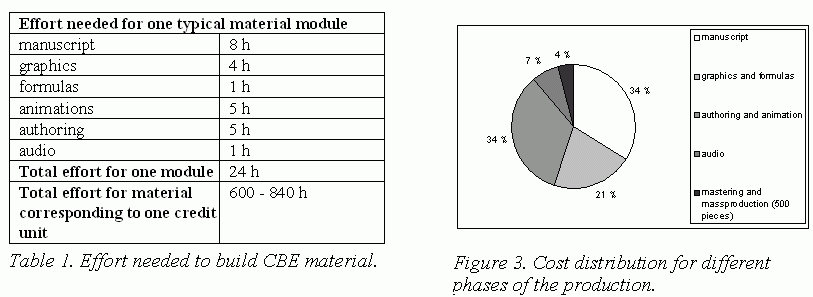
Fig. 3 presents the cost distribution for the different phases of the production, in the case where the distribution channel consists of a CD-ROM. It should be observed that the delivery and mastering costs do not play a significant role in the overall cost distribution.
The software was implemented by using Macromedia Director authoring tool and standard graphic production tools, voice production tools and equation editors. The results from the students' hardware survey were used for setting the minimum computer configuration for the CBE program, namely a Pentium-level processor, 16-bit colour mode, monitor with resolution 800 x 600, Soundblaster compatible soundcard, CD-ROM drive and mouse.
Fig. 4 presents a screen view of the conceptual learning section and the in-depth learning section. The user first selects a suitable module in the conceptual learning section and then moves to the in-depth learning section simply by double-clicking the desired module.
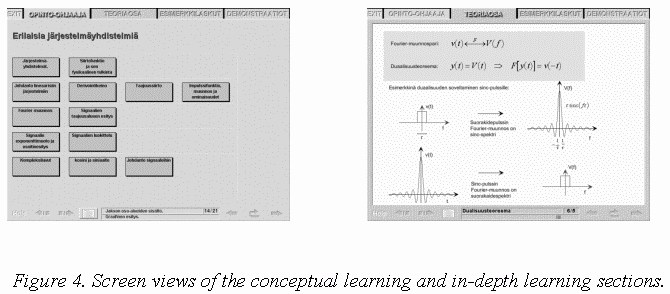
When producing multimedia material, there is a trade-off between the quality of the material and development cost. The target in our case was to produce material which benefits from the use of multimedia methods like animation and visualisation. To find out if this target had been achieved, we distributed the software on a CD-ROM to all students that took part in the "Signals and Systems" course. The multimedia material was selected to cover all main areas of the course material, and the students used the CD-ROM in conjunction with the traditional learning methods. After the examination, we conducted a survey in which the students were asked to estimate the usefulness of the CBE software. The results of this survey are presented in Fig. 6. The majority of the students who took part in the survey felt that there was a clear benefit of using the program. 13 % of the students were of the opinion that the multimedia material was crucial to them for understanding the course content.
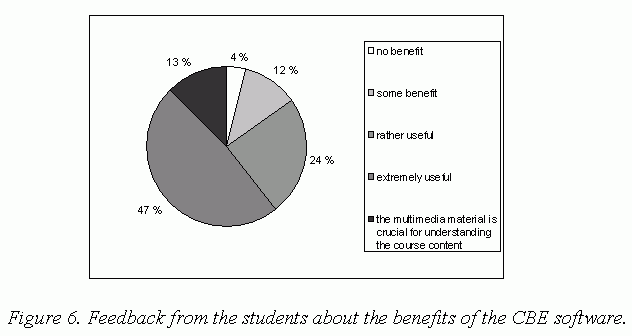
The students were also asked to name the most advantageous part of the CD-ROM. The most popular choice was "convolution", which is one of the basic principles described in the course. The examination usually includes one task from this area, and thus the examination results can be compared to previous results. In Fig. 7, three examination results are shown. The latest result is from an examination that was held in spring 1999, when the students could use the CD-ROM in preparing for the exam. In spring 1998, the students could use the pilot version of the software, containing 30 % of the course material. In four exams during the years 1996-1997, the students did not have any multimedia material available. It can be observed that there is a clear improvement in the examination results. The comparison of the different examination results is not, however, straightforward. Small variations in the degree of difficulty of the exam tasks - and the change of examiner from one task to another - make a straight comparison difficult.
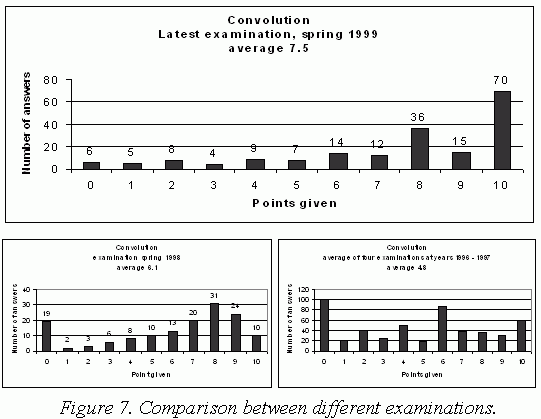
In this paper, we addressed the production and evaluation of CBE material. First, we investigated how the students were following the trends in hardware development. A high computer penetration among the students was observed, and the quality of the equipment also turned out to be high. Secondly, we shortly described a CBE concept that was developed during an earlier pilot project. Thirdly, we analysed the effort needed for producing the material, employing the existing CBE concept. With modern production tools and methods, 600 - 840 hours of work was required for producing the material corresponding to 1 credit unit. Finally, we evaluated the implemented software and CBE concept by collecting feedback from the students and comparing the latest examination results to previous examinations. The feedback from the students was very positive, and a large majority believed that there was a clear benefit from using the CBE software while studying the course content.
The authors wish to thank PhD. Kai Hakkarainen from the Department of Psychology of the University of Helsinki and Lic.Tech. Michael Hall from the Helsinki University of Technology for valuable comments and suggestions.